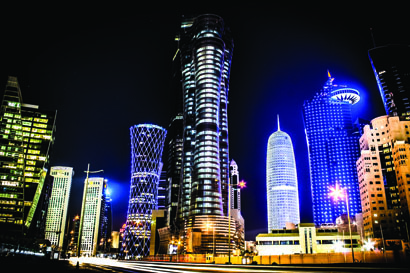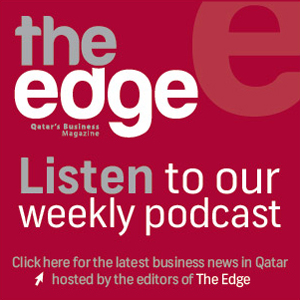Energy security: Kahramaa’s solar ambition
Water and utility provider for the State of Qatar, Kahramaa, recently revealed its plans for a Mega Reservoir Project, consisting of a network of five mega water reservoir sites across Qatar, which at completion would provide a week’s worth of water storage in accordance with the anticipated demand in 2036. Fortuitously, these facilities also presented Kahramaa the opportunity to announce a pilot renewable energy project that will result in solar panels being installed atop these reservoirs. The aim of the solar project, says Kahramaa’s head of renewable energies, Eng. Saleh Hamad Al Marri, is to contribute in a large part to the target of two percent of Qatar’s electricity output by 2020 that is to come from renewable energy. The Edge’s Miles Masterson spoke to Al Marri about the project and Kahramaa’s decision to pursue solar as a renewable energy solution for Qatar.

Kahramaa of course has a vested and critical interest in any renewable energy project, explains Al Marri, through a connection to Qatar’s electricity grid, and as a provider of related facilities. “We have a strong collaboration with Qatar Foundation (QF) for this,” he says, in reference to research and development that has been conducted by these institutions in recent years, including facilities at QF, Qatar National Convention Centre and the Solar Testing Facility at Qatar Science and Technology Park (QSTP).
Al Marri is clear as to the primary reason Kahramaa is taking renewable energy, in particular solar, so seriously: energy security. As all of Qatar’s electricity is currently produced via gas turbines, relying solely on fossil fuels for energy is a high-risk proposition, he says. “Any interruption in oil and gas supplies would have huge implications on our energy resources and for the government,” Al Marri explains. Thus the next reason is to provide an alternative to conventional electricity sources during peak periods, to provide another source in case there is a need for it in what he calls “site demand management”.
Thirdly, but no less importantly, is the positive contribution utilising solar energy has on carbon and other noxious emissions inherent in hydrocarbon-based energy processes. “We want to minimise gas releases such as CO2 and monoxide and the other ‘Nox’ [nitric oxide and nitrogen oxide],” justifies Al Marri.
The overriding solution, he then explains, is to develop what Al Marri calls a “cocktail” of energy sources, adding that as the sole state utility provider Kahramaa is the only corporation in the country to lead the sector. “If Kahramaa does not promote it, who will?” he asks rhetorically. “We know solar is too expensive at this moment, but we are trying to use it in a wise way, in order to minimise the cost. We are doing it in a very special way so as to not incur expenses for the land, because we are using our rooftops in our reservoirs; and we are trying to maximise the offset of the natural gas that would be burned, to produce this electricity, in order to sell it in the global market.”
The final frontier
Although it would seem to the casual observer there are ostensibly large tracts of unused land outside of the Qatari capital Doha, that might be perfect for solar farms, which require a lot of space, Al Marri is quick to dispel such an idea. In doing so he also underlines the genius of creating a dual purpose for the mega reservoirs, as well as Kahramaa’s commitment to running its operations with a business-like approach, despite being a state function.
Space for projects of such scale, reveals Al Marri, is actually a real issue for Qatar. “We have good solar radiation,” he explains, “but Qatar is only 11,000 square kilometres (m2), which is not that big. And you cannot use many spaces or most of the spaces in the country, because these are either natural reserves or set aside for use for future generations. So this is why we are using the rooftops of our water reservoirs…which are areas that nobody else would use.”
These rooftops, Al Marri estimates, tally to roughly one million sqm of space, and though he concedes not all of it might be wholly suitable, most of it is perfect for solar farms. “One of them, the first package at Al Duhain, is expected to be awarded this quarter,” discloses Al Marri.
On the subject of a business-like approach, Al Marri explains Kahramaa’s motivation behind developing its relationship with renewable energy as one of clearly defined phases. Apart from the challenge in finding space – a key issue they have, of course, so far solved by utilising the reservoirs – he adds that there is some reluctance to embrace this new path and so they will be unrolling it package by package, learning from each and refining the process and expanding the reach and output incrementally.
“We will do it step by step, in a very cautious way, just to make sure that we are on the right track,” confirms Al Marri. “We don’t want to spend a lot of money and make a mistake that could have been avoided because we did it too quickly…Kahramaa is working on a commercial basis. It’s a government entity yes, but we are working to increase our annual performance. We’ve made a few initial models and we have done preliminary studies to make sure that we are going to benefit from these projects.”
Advantages and disadvantages
The conversation then turns to the pros and cons of embracing solar in Qatar. On paper it can seem like an ideal solution for such a sunny climate, but there are some major challenges. The country also has some distinct advantages to leverage, though, as Al Marri highlights. Indeed, on the upside, a major plus for Qatar is that its electricity grid is relatively young. Some parts are slightly dated, he admits, but the vast majority of the network is less than 15 years old.
“It is easy to make it compatible with solar,” explains Al Marri further, adding that apart from the photovoltaic cells (PVC) that make up the solar panels, most of the equipment used is the same and because there are electricity network facilities already installed at the reservoirs, such as an 11 kilowatt (KW) substation for which “the distribution is the same as for the pump house that is pumping this water, which also minimises the cost,” as Al Marri points out.
“Maintenance and operations of solar is not that complicated and the main cost is the panels,” he continues. “The other issues you talk about are transformers or converters or cables. These are being used on a daily basis in the Kahramaa network anyway. So it’s not that big a deal. There are no new items or anything else that’s new to us. We just need to customise it for solar and that’s it.”
Further advantages for Qatar are its connection to regional electricity grids and its proximity to well-developed solar and renewable energy infrastructures in surrounding countries such as Saudi Arabia and the United Arab Emirates (UAE), as well as membership of various regional and international energy-related bodies. These include the Gulf Cooperation Council Interconnection Authority (GCCIA), which joined the GO-15 Reliable and Sustainable Power Grids network in 2014, and the Arab Union of Electricity.
“Also there is IRENA, which is the International Renewable Energy Agency,” furthers Al Marri, adding that such connections and relationships enable Qatar to learn from its counterparts in the region and internationally, through workshops and other forms of communication. “Other parties share their experience and we do presentations, we share our experience,” he explains. “This is how we learn to avoid mistakes made in Saudi Arabia or the UAE, for example…we have continuous cooperation and information exchange.”
On the downside, the high expense of photovoltaic cells (PVC) themselves, as well as other aspects of solar farm installations have long been prohibitive factors. But recently the production costs have been reduced dramatically. Qatar companies are also beginning to manufacture PVCs and related products, though Al Marri insists that though they would be happy to support local entities, it must be cost effective. “We are looking for the best PVC panels,” he says. “If there is a local product we will support it heavily. But we will not support anything that’s not feasible. If it’s a really good product, we’ll support it 100 percent because we are here to support the sector.”
Apart from the above, the extreme weather in Qatar is a major issue. The combination of excessive heat in summer, humidity and dust/sand can denigrate solar installations faster than elsewhere in the world. Al Marri, however, seems confident that this challenge can be overcome through continued research and development by entities such as the Qatar Environment and Energy Research Institute (QEERI), QSTP and Qatar University, and mentions an upcoming workshop aimed at specifically this issue.
Realistic goals
The goal as set by the State of Qatar for energy output from renewables by 2022 is 10,000 megawatts (MW). This is two percent of the total projected output required of 200,000 MW by that date. Al Marri believes this a realistic target. “In Japan or the United States or France, the mix is more in line with Qatar’s aims,” he adds.
In terms of the headstart that these countries have had on Middle Eastern states in developing renewable, particularly solar, Al Marri explains that it has for a long time been more cost effective for them to do so due to the high oil price. The recent decline in oil price notwithstanding, he continues, “we have another issue that they don’t have. We have a water problem. One barrel of water costs us maybe double or triple of one barrel of oil. This is a big, big problem for us. So this is why we are thinking to use technology such as solar to desalinate water or to produce water from our plant with solar technologies.”
Moreover, Al Marri reiterates the cautious approach taken by Kahramaa is the most sensible. “If you want to jump to any technology like solar, you cannot wait until the price of energy or the technology comes down, because this might only come after 10 years or more. Maybe by then it will be too late. So if you want to jump into something, you need to do it gradually, and not necessarily to go heavily in this industry immediately. So yes we are optimistic, but we are also very cautious and realistic,” Al Marri closes.
Like this story? Share it.






